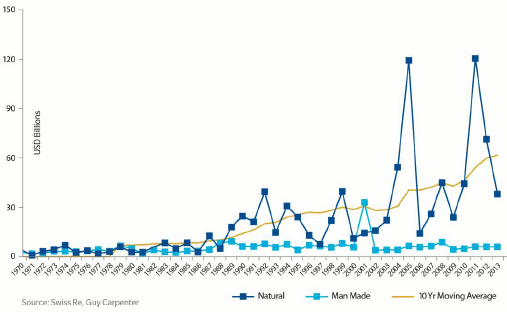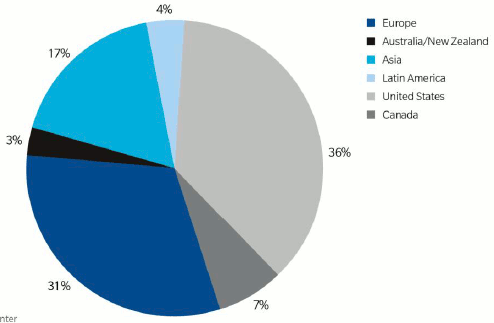2013 gave the reinsurance industry a respite, following two above-average years of losses in 2011 and 2012. Insured losses in 2013 from natural catastrophes and man-made disasters are estimated at around $40 billion, according to reinsurance broker Guy Carpenter.
Guy Carpenter has published its 2013 Catastrophe Review, which looks at the trends in natural catastrophes and man-made disasters during 2013 and how these impacted the insurance and reinsurance industry. The insured loss total in 2013 was well below the 10-year average of around $60 billion, according to Guy Carpenter.
“Last year will likely be known as the ‘year of the flood,’ with significant global flood events affecting Central Europe, Australia, Canada and the United States,” commented Julian Alovisi, Vice President for Guy Carpenter. “Although 2013 was relatively quiet compared to past years, several major events such as the tornado outbreaks in the U.S., floods, hail and windstorms in Europe and Typhoon Haiyan in the Philippines inflicted widespread devastation and significant losses on impact.”
While insured losses were low in 2013 the graph below, taken from Guy Carpenter’s report, clearly shows the rising trend in global disaster losses. The 10 year moving average has been steadily rising each year, the peaks have got higher and even the lower years would have been near record losses only 15 years ago.

Global catastrophe insured losses 1970 - 2013
The U.S. continued to be the leading source of catastrophe insured losses in 2013, but was closely followed by Europe where flooding and hail storm impacts caused major insured losses. Asia’s contribution to global losses continues to grow and this slice of the chart is expected to be the one which widens fastest in years to come. Conspicuously absent is Africa, reflecting the low-level of insurance penetration on that continent.

Distribution of catastrophe insured losses in 2013 - Source: Guy Carpenter
Guy Carpenter details some of the key natural catastrophe loss events by region.
Europe, Middle East, Africa
Central Europe experienced the worst flood event of 2013. Persistent heavy rain caused major rivers to overflow their banks and in some cases, flood defenses were breached. Germany in particular was badly affected as the floods inundated countless homes, businesses and crop fields. Estimated insurance losses from this event were approximately $4.1 billion, with economic losses of about $18 billion.
To further compound the devastation, the flooding was followed by a series of hail events in late July. In particular, Hailstorm Andreas damaged approximately 100,000 properties and 50,000 cars in the northern and southern regions of the country. This event became one of the costliest natural disasters to hit Germany, with estimated insured losses of $3.7 billion. A series of severe windstorms in Northern Europe also caused significant damage in the autumn and early winter months, with insured losses from Windstorms Christian and Xaver totaling approximately $1.4 billion and $925 million, respectively.
In 2014, soil saturation will be a major concern for many areas of Europe, further amplifying the risk of flood during normally wet months.
Asia/Australasia
In 2013, Asia and Australasia were impacted by both natural and man-made catastrophes. The most costly man-made event occurred in China after a major fire hit a large microchip factory in September. Reports estimated that the cost to the (re)insurance sector totaled $1.3 billion, making it the most expensive single-risk loss of 2013. The region was also hit by a number of natural catastrophes in 2013, the first of which occurred in Australia in the form of severe flooding. This event incurred insured losses of approximately $1 billion, according to the Insurance Council of Australia.
Meanwhile, in the Northwest Pacific Ocean, there were 29 named storms, 16 typhoons and seven super typhoons, with an explosive increase in tropical cyclone activity in the mid-to-late-autumn months. November’s Super Typhoon Haiyan was possibly the most powerful landfalling tropical cyclone on record. Haiyan tragically inflicted over 7,000 fatalities and severe damage to the Philippines due to extreme winds and storm surge. The super typhoon incurred insured losses of $1.5 billion, according to the Philippine Insurers and Reinsurers Association, with a total loss of approximately $10 billion.
Americas
The Americas were also impacted by flooding in 2013, with notable events occurring in Alberta, Toronto and Colorado. In the Calgary, Alberta region of Canada, flooding caused an estimated $2 billion in insured losses, with economic losses of $4.8 billion. This flood event, coupled with flash flooding in Toronto, Ontario in July, meant Canada experienced its most expensive insured catastrophe loss year on record.
Despite the relatively quiet tornado season in the United States, there were a handful of severe thunderstorm outbreaks. Most notable was the outbreak in May that affected the Southeast, Midwest and Southern Plains. This outbreak spurred the devastating Moore, Oklahoma tornado which caused insured losses of approximately $1.8 billion. Another burst struck shortly after the Moore event, affecting the Midwest and Southern Plains and included the El Reno tornado, which incurred insured losses of $1.4 billion.
“Heading deeper into 2014, we are very concerned about the water situation in the state of California,” James Waller, PhD, Research Meteorologist for GC Analytics®. “In 2013, California experienced the lowest precipitation in recorded history for the state. This has already led to exceptionally severe drought conditions in the area. If these conditions continue to persist, lasting and significant impacts to water resources, agriculture and an aggressive wildfire season will be major areas of concern.”
2013 Hurricane Season
The 2013 Atlantic Hurricane season was one of the most inactive on record. The most noteworthy events of the 2013 hurricane season were the landfalls of Hurricane Ingrid (Atlantic) and Tropical Storm Manuel (Pacific) in Mexico in September. These storms caused excessive rainfall, flooding and mudslides, causing thousands to be displaced. The combined estimated insured losses for these events totaled $920 million, according to the Mexican Association of Insurance Institutions.
Only five other seasons since 1970 had less activity than 2013 in the Atlantic basin. The quiet season was in part due to persistent dry, stable air over large portions of the Atlantic main development region. The inactive season was unexpected given statistical forecasts for above-average activity provided by seasonal outlook providers. There is, however, no guarantee that the 2014 Atlantic hurricane season will be like the 2013 season.
Download the full report from Guy Carpenter in PDF format.
 View all of our Artemis Live video interviews and subscribe to our podcast.
View all of our Artemis Live video interviews and subscribe to our podcast.
All of our Artemis Live insurance-linked securities (ILS), catastrophe bonds and reinsurance video content and video interviews can be accessed online.
Our Artemis Live podcast can be subscribed to using the typical podcast services providers, including Apple, Google, Spotify and more.































